Edge AI for Real-Time Analytics
Edge AI for real-time analytics is transforming how organizations use artificial intelligence in dynamic environments. At its core, edge AI refers to the deployment of AI models and AI algorithms directly on edge devices—including IoT sensors, cameras, smartphones, gateways, and even wearable devices. Instead of transmitting raw data to distant cloud servers for processing, edge AI processes data locally, closer to where it is generated.
This design offers several key benefits:
Reduced latency: Decisions happen instantly because models run on local edge devices, avoiding delays from transmitting data across networks.
Real time decision making: Critical for applications like autonomous vehicles and predictive maintenance alerts, where milliseconds matter.
Improved data security: Sensitive information remains processed locally instead of being stored in cloud systems, reducing exposure.
Cost efficiency: Decreased data transmission lowers bandwidth usage and reliance on costly cloud infrastructure.
Scalability: Thousands of edge devices can run AI simultaneously, supporting massive ai applications in various industries.
The global edge AI market is accelerating, driven by smart manufacturing, autonomous vehicles, and edge technologies that demand real time data processing without reliance on central cloud computing facilities.
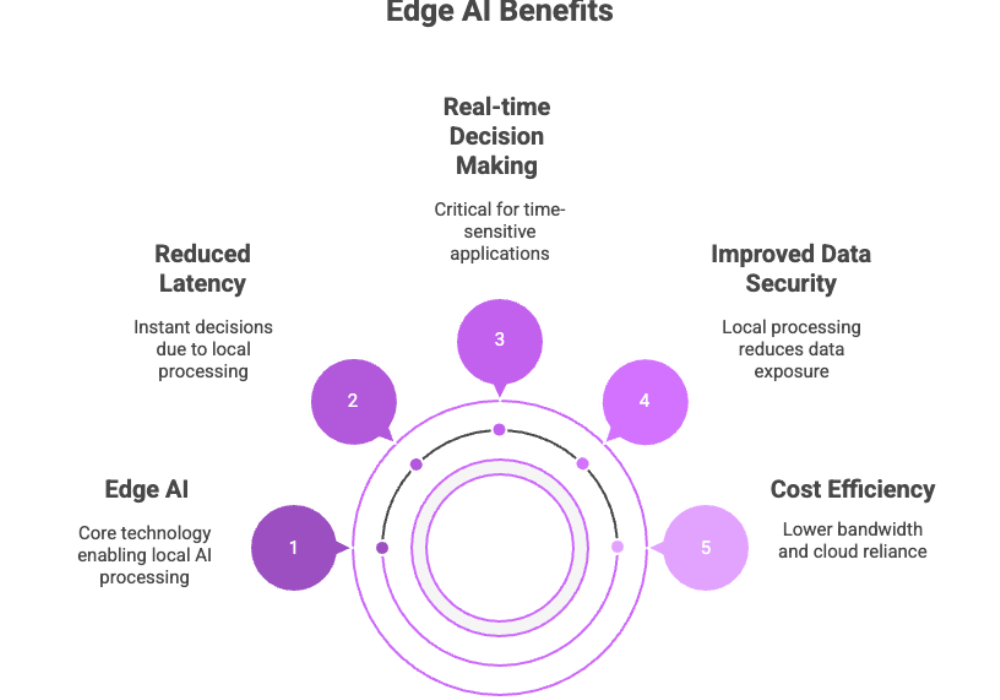

Edge AI vs. Cloud Computing
Both edge AI and cloud computing play central roles in modern AI applications, but they differ in capabilities, latency, and scalability.
Edge AI:
Focuses on local data processing and real time analysis.
Runs machine learning models and deep learning networks directly on edge devices.
Ensures enhanced privacy by keeping data locally.
Enables real time decision making in environments with limited internet connectivity.
Cloud AI:
Provides vast computational power for complex AI tasks like training complex AI models.
Ideal for large scale data analysis such as business intelligence or data warehousing.
Relies on cloud infrastructure and global cloud systems, making it less resilient to network latency or outages.
Requires sending data continuously to remote servers, raising data security and privacy concerns.
Key differences in practice:
Latency: Edge = milliseconds, Cloud = seconds (or more under poor connectivity).
Data security: Edge = safer (sensitive data stays local), Cloud = higher risk due to storing data centrally.
Computing power: Cloud = higher scalability, Edge = optimized for local processing.
Hybrid approaches are increasingly common: train and refine AI models in the cloud, then deploy optimized inference engines on edge devices for real time processing.


AI Models and Algorithms
The strength of edge AI lies in its use of ai models and ai algorithms optimized for local edge devices. These models must balance accuracy with efficiency, as edge environments have limited computing power compared to data centers.
Types of AI models for Edge AI:
Machine learning models: Lightweight models for predictive maintenance, smart homes, and quality control.
Deep learning networks: Convolutional and recurrent neural networks adapted for real time data such as video streams in autonomous vehicles.
Neural networks (compressed): Quantized and pruned models optimized for edge ai capabilities with limited resources.
Applications of AI algorithms in Edge AI:
Predictive maintenance alerts: Identifying anomalies in sensor data before machinery fails.
Object detection: Computer vision AI applications in surveillance, retail, or smart manufacturing.
Autonomous decision making: Self driving cars use optimized ai algorithms for split-second decision making.
Data filtering and aggregation: Reducing noise in incoming data streams for faster insights.
By deploying advanced AI models with ai accelerators, edge AI balances accuracy, energy efficiency, and scalability edge performance.
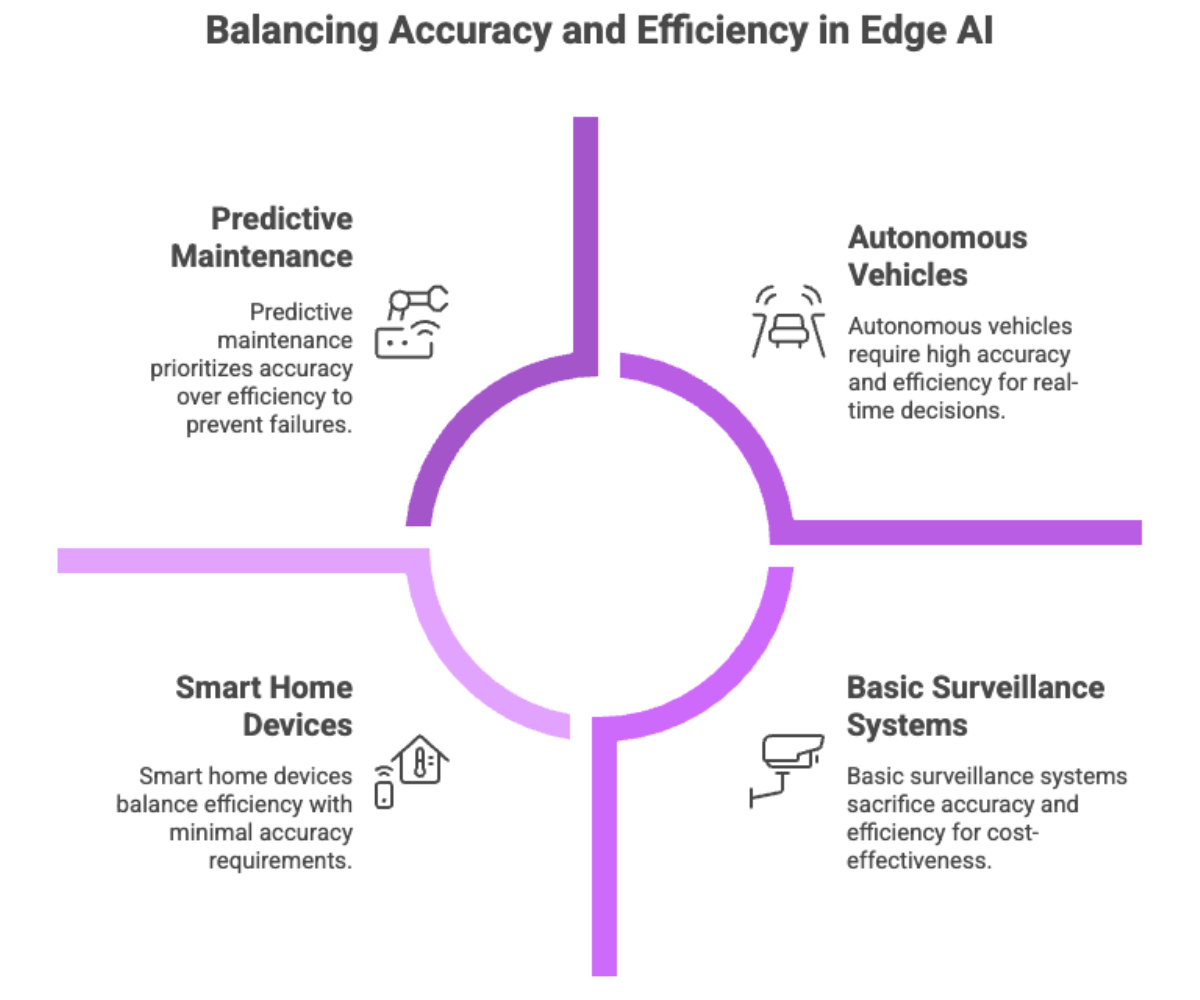

Data Processing and Analysis
One of the strongest benefits of edge AI for real use cases is real time data processing directly on edge devices. Instead of sending data continuously to cloud servers, data generated by IoT sensors, cameras, and industrial machines is processed locally.
Capabilities of Edge AI in data processing:
Data filtering: Removing irrelevant or noisy raw data before storage or transmission.
Data aggregation: Combining multiple data sources for context-aware insights.
Real time analytics: Running ai models for immediate results, enabling instant decision making.
Learning from data locally: Using machine learning and deep learning networks for continual improvement of model performance.
Example applications:
In industrial automation, edge devices track temperature, vibration, and pressure, triggering predictive maintenance alerts.
In healthcare, edge ai applications analyze medical scans on edge hardware, preserving patient privacy while ensuring instant results.
In retail, smart cameras perform quality control by identifying defects or empty shelves in real time data streams.
These edge ai capabilities deliver increased efficiency, data control, and cost savings, making edge AI for real-time analytics essential across various industries.
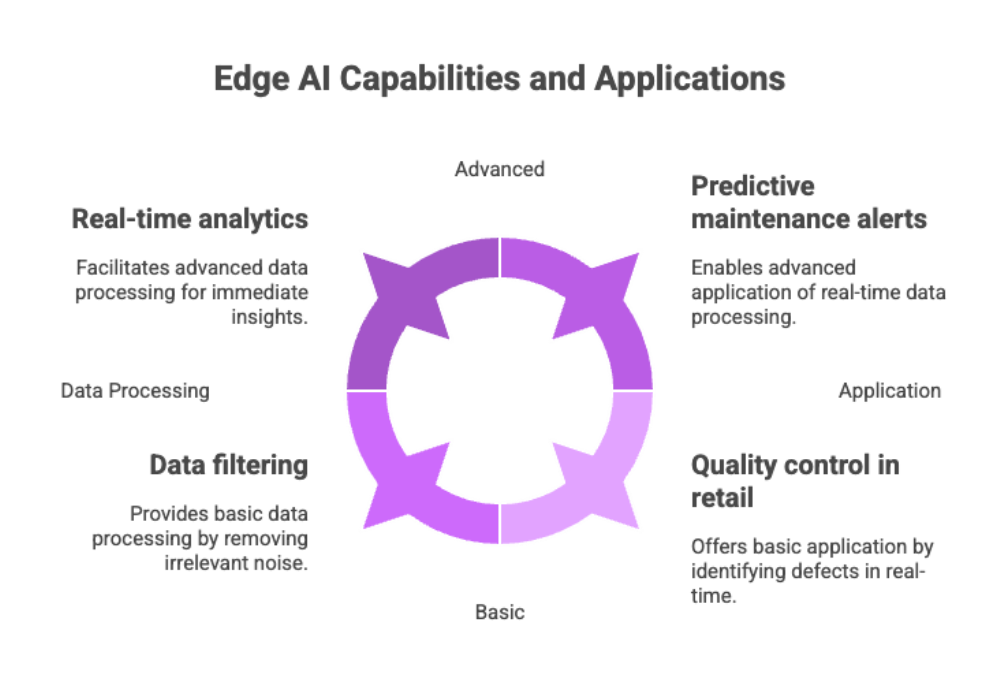

Distributed AI and Edge AI
While edge AI focuses on deploying AI models on edge devices for real time data processing, distributed AI expands this concept by coordinating AI tasks across multiple nodes — both cloud AI infrastructure and local edge devices.
In practice:
Distributed AI distributes ai tasks across multiple edge environments and cloud systems, ensuring balanced computing power.
Edge AI focuses on processing data locally, enabling faster responses in real time data streams.
Benefits of combining distributed AI and edge AI:
Scalability edge performance: Thousands of local edge devices can collaborate in processing incoming data streams.
Flexibility: Supports both complex AI models in the cloud and lightweight machine learning models at the edge.
Reliability: Systems continue functioning even if one edge node or cloud infrastructure component fails.
Data security: By storing data and processing data locally, sensitive information avoids exposure to cloud servers.
Example:
In smart manufacturing, a distributed AI framework might run deep learning networks in a data center for model training, while edge AI models deployed on factory sensors handle predictive maintenance alerts and quality control in real time data environments.
Together, distributed AI and edge AI create robust, scalable systems capable of solving real world problems while keeping sensitive data secure.


Autonomous Vehicles and Edge AI
One of the most advanced edge ai applications today is in autonomous vehicles. These systems must process vast streams of sensor data from LIDAR, radar, and cameras in real time. Relying on cloud AI alone would be impossible due to latency and network constraints.
How edge AI supports self-driving cars:
Real time decision making: Edge ai processes data instantly on-vehicle, ensuring immediate actions such as braking, lane changes, and collision avoidance.
Fault tolerance: Even if internet connectivity is lost, the car continues operating autonomously with local processing.
Predictive analytics: Vehicles anticipate hazards — like a pedestrian entering the road — based on ai algorithms analyzing real time data.
Enhanced security: Data locally processed avoids continuous sending data to the cloud, protecting passengers’ privacy.
Edge AI capabilities in autonomous vehicles include:
Predictive maintenance: Monitoring tire wear, battery status, and mechanical stress using sensor data.
Real time monitoring: Constant evaluation of road and environmental conditions.
Autonomous decision making: Combining multiple ai algorithms into a unified inference engine for split-second decision making.
Without edge computing, autonomous driving would face delays and substantial computational power costs that make it unsafe. Edge AI for real time analytics ensures these vehicles operate reliably and securely on the road.
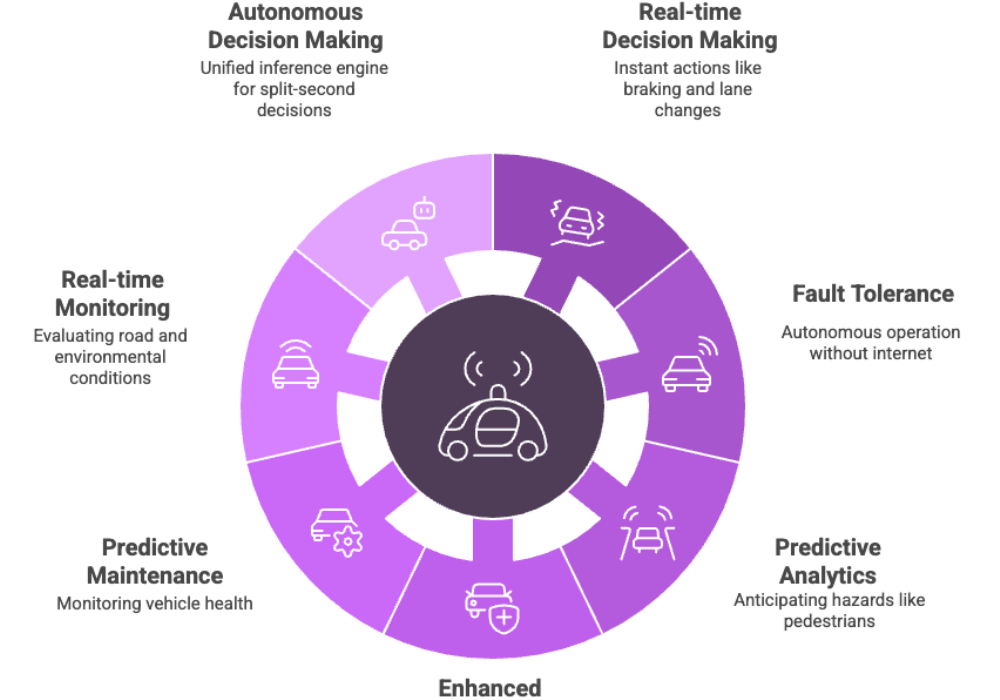

Edge AI in Various Industries
Expanding Edge AI ApplicationsWhile autonomous vehicles get much attention, edge ai applications extend far beyond transportation. Various industries are already deploying edge AI for real-time analytics to optimize business operations, save time, and accelerate innovation.
1. Manufacturing (Smart Manufacturing / Industrial Automation):
-
Edge devices track vibration, temperature, and humidity for predictive maintenance.
Quality control cameras use machine learning models for object detection of defects.
Real time decision making on production lines prevents bottlenecks and downtime.
2. Healthcare:
-
Edge AI models analyze sensor data from wearables for real time monitoring of patients.
Data security and patient privacy are preserved by processing data locally instead of storing data in remote cloud systems.
Predictive analytics assists doctors with faster diagnostics.
3. Retail and E-Commerce:
-
Smart cameras and edge devices monitor inventory with ai algorithms for quality control.
Personalized recommendations are generated with local data processing to reduce internet bandwidth reliance.
Fraud detection systems use real time data to identify anomalies instantly.
4. Smart Cities:
-
Traffic control systems powered by edge AI analyze camera feeds for congestion and safety.
Energy efficiency is achieved by edge technologies dynamically managing lighting and utilities.
Public safety systems rely on edge ai models for real time monitoring of critical infrastructure.
5. Industrial Environments:
-
Rugged edge devices and controllers run ai models even in harsh conditions.
Workplace safety improves with edge AI capabilities monitoring worker fatigue or hazardous environments.
Operational efficiency is optimized by combining distributed AI and edge AI into unified ai applications.
Why this matters: Across various industries, edge AI for real-time analytics transforms business processes by lowering costs, preserving sensitive data, and supporting decision making that once relied solely on slow, centralized cloud computing facility models.
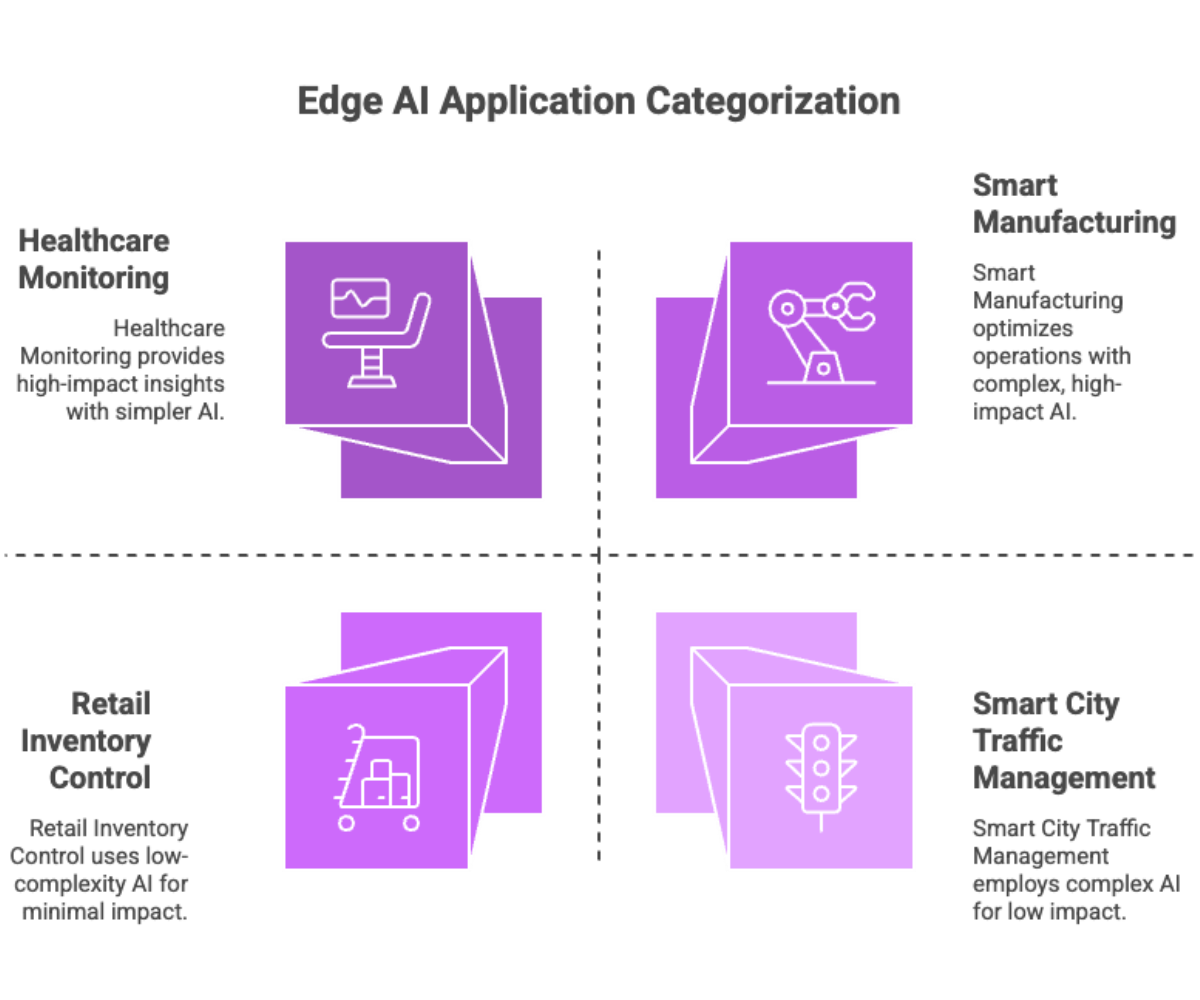

Cloud AI and Edge AI in Harmony
While edge AI is critical for real time data processing, cloud AI remains essential for training complex AI models.
Cloud AI strengths:
Uses vast computational power in cloud infrastructure for ai model training.
Supports data scientists working with big data for algorithm improvement.
Aggregates updates in federated learning models from thousands of edge devices.
Edge AI strengths:
Runs inference engines directly on edge hardware for real time decision making.
Processes data locally, avoiding constant data transmission to cloud servers.
Ensures sensitive data stays secure while enabling ai applications in various industries.
The future lies in hybrid systems:
Cloud systems handle training and further training of advanced AI models.
Edge devices run optimized ai algorithms and machine learning models for real time processing.
This synergy balances substantial computational power in the cloud with edge ai capabilities in local environments, ensuring scalability, privacy, and real time analytics.
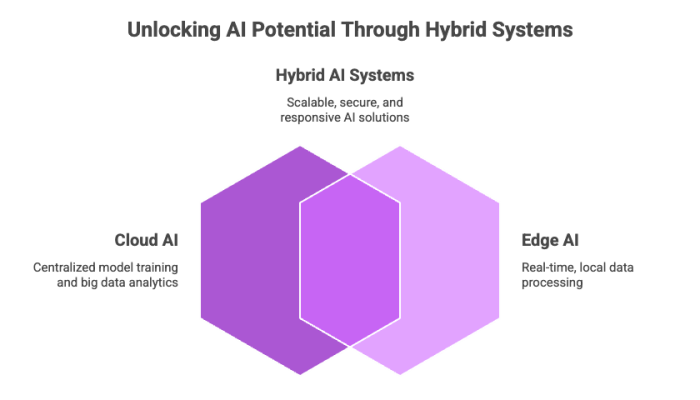

Edge AI Today and Tomorrow
Edge AI for real-time analytics is no longer an experimental technology — it is already reshaping industries by enabling real time decision making close to where data is generated. By bringing artificial intelligence out of centralized cloud servers and into edge devices, businesses gain faster insights, stronger data security, and new opportunities for automation.
The global edge AI market is projected to grow exponentially, fueled by insights into AI strategies and tech trends:
Proliferation of IoT devices in smart cities, healthcare, and manufacturing.
The need for real time data processing in critical environments.
Increasing importance of protecting sensitive data through local processing.
Advances in edge hardware such as ai accelerators and neural processing units.


Advanced AI Models at the Edge
One of the biggest trends is the deployment of advanced AI models on compact, energy-efficient edge devices. While traditionally complex AI models required vast computational power only available in cloud infrastructure, new breakthroughs in model compression, transfer learning, and quantization make it possible to run AI models locally.
Future edge AI applications will integrate:
Inference engines optimized for raw data streaming from sensors.
AI accelerators embedded into edge hardware to handle complex AI tasks with low power consumption.
Real time analysis pipelines that enable near-instantaneous decision making in safety-critical systems like autonomous vehicles and industrial environments.
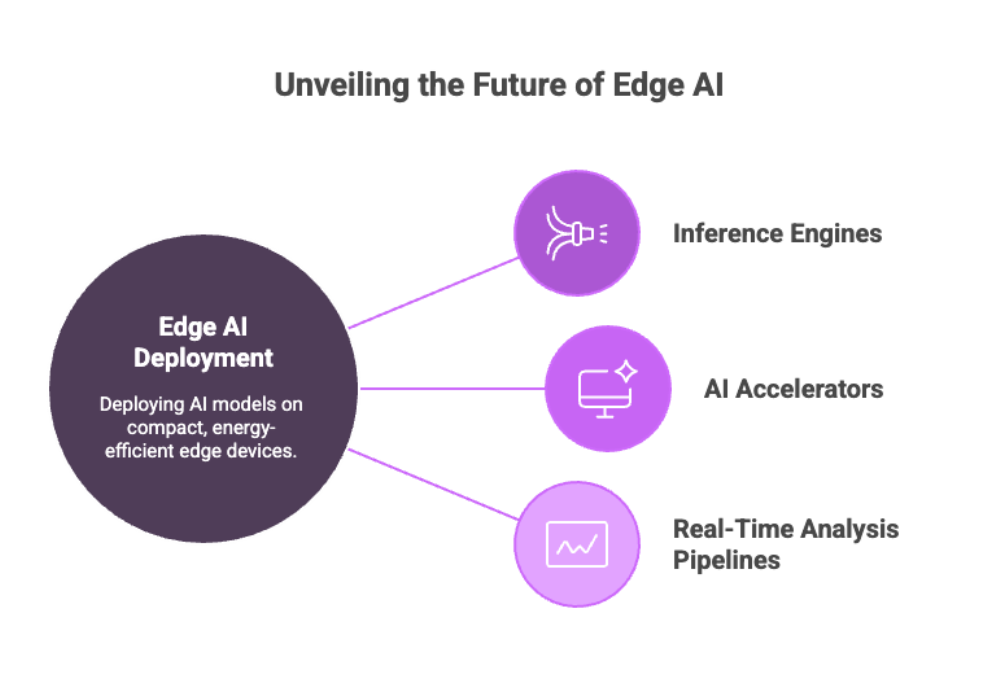

Challenges and Considerations
As promising as edge AI for real-time analytics is, organizations must address key challenges to unlock its full potential:
Compute Infrastructure: Some edge environments still lack sufficient computing power to handle advanced AI models.
Standardization: A fragmented ecosystem of devices, edge platforms, and frameworks makes deploying edge AI complex.
Data Security: While processing data locally enhances privacy, sensitive data on distributed edge devices must be protected from security risks.
Scalability: Managing thousands of local edge devices running ai applications requires reliable orchestration and monitoring.
Energy Efficiency: Balancing real time processing with low energy consumption will be critical as edge AI scales to billions of devices.
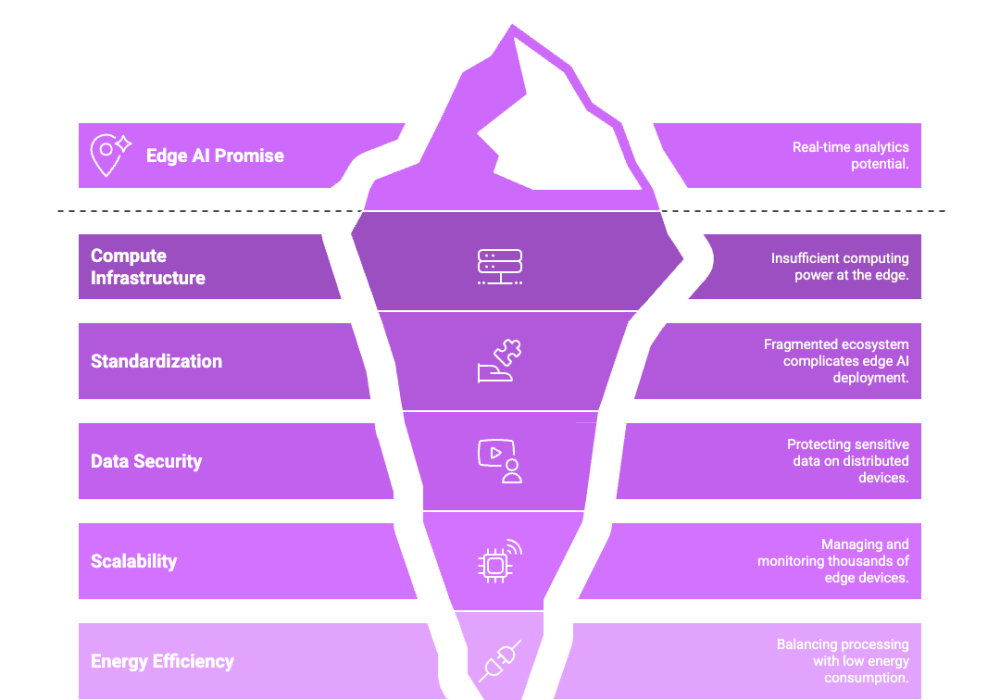

Future Trends in Edge AI
Looking ahead, several trends will define the future of edge AI and real-time analytics:
Hybrid Cloud + Edge AI Systems: Cloud will continue to handle ai model training, while edge devices will specialize in inference at the edge, creating seamless collaboration.
Federated Learning at Scale: With regulations like GDPR and HIPAA, federated learning will expand, enabling ai tasks on-device while preserving privacy.
Edge AI in Smart Cities: From traffic control to worker safety, real time monitoring systems will drive safer, more efficient urban environments.
Industrial Edge AI: Smart manufacturing will rely on ai algorithms to optimize workflows, minimize downtime, and enhance operational efficiency.
Healthcare Applications: Wearable devices and diagnostic tools will provide real time data insights while keeping patient privacy intact.
AI Accelerators Everywhere: As costs fall, ai accelerators will become standard in edge hardware, supporting both simple AI models and complex AI models in real time analysis.
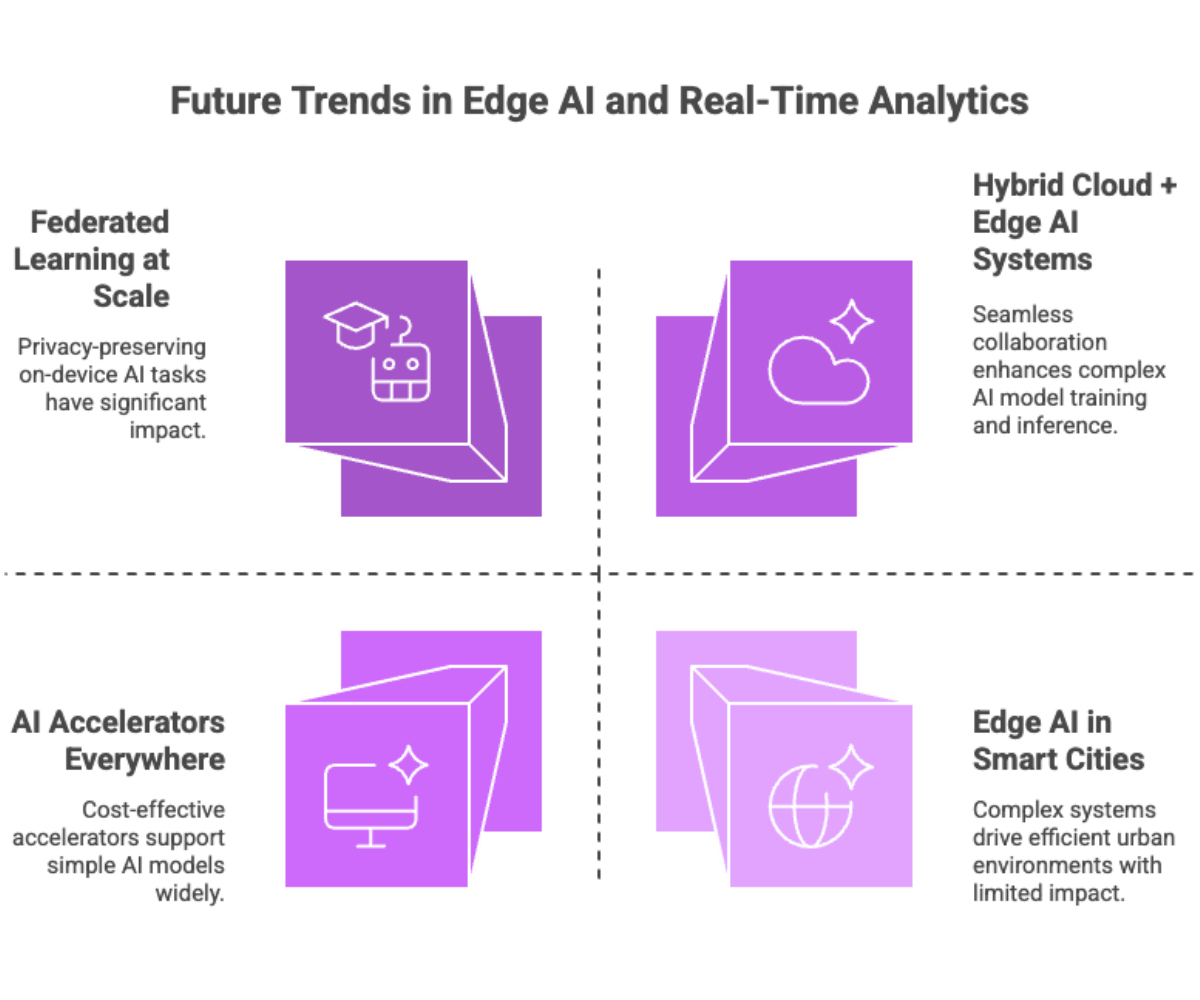

Final Word
The rise of edge AI for real-time analytics marks a fundamental shift in how organizations leverage AI applications. Instead of sending everything to the cloud computing facility, businesses are unlocking the power of processing data locally.
By deploying edge AI models on edge devices, industries gain:
Faster real time decision making.
Stronger data security for sensitive data.
Lower operational and bandwidth costs.
More autonomous, reliable, and scalable ai applications.
In essence, edge AI is becoming the nervous system of modern technology — enabling smart, distributed, and secure intelligence at the network edge. Its combination of edge computing, ai models, and real time analysis ensures that the future of AI at the edge is not only more powerful, but also more human-centric, privacy-aware, and efficient.


